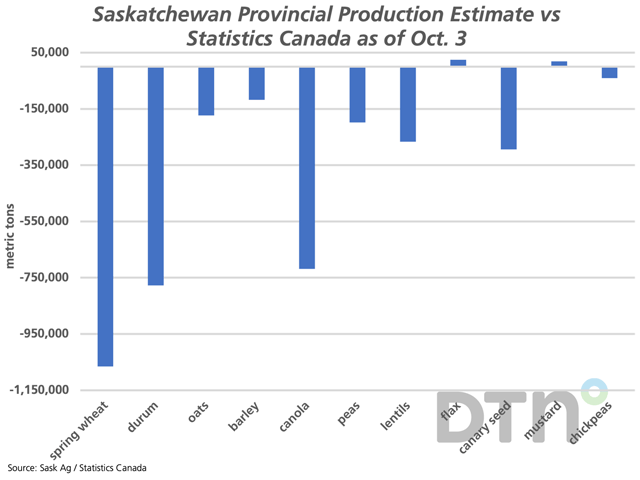Canada Markets
Saskatchewan Ag Estimates Vary Significantly Compared to Statistics Canada Production Figures
Saskatchewan Agriculture tweaked their provincial yield estimates for the first time in close to one month this week and some glaring differences remain when results are compared to the official Statistics Canada estimates.
The question remains if this difference is due to timing or methodology. When it comes to timing, the first provincial yield estimates were released on September 5, when 42% of the crop had been harvested across the province. The most recent estimates are for the week ending October 3, with an estimated 90% of the crop in the bin. This compares to the official estimates from Statistics Canada, which were based on August model results.
In addition, Saskatchewan's estimates are based on walking fields and discussions with producers either on the combine or in the process of parking machinery for the winter, while Statistics Canada has based their estimates on satellite model data.
P[L1] D[0x0] M[300x250] OOP[F] ADUNIT[] T[]
This week, the Saskatchewan government tweaked its estimates. The spring wheat, durum and field pea yield estimates were left unchanged at 43 bushels per acre, 30 bpa and 34 bpa, respectively. The canola and flax yield estimates were increased by 1 bpa to 35 bpa and 24 bpa, respectively. The oat yield was increased by 9 bpa to 89 bpa and the barley yield was reduced by 2 bpa to 62 bpa.
Looking at the changes seen for special crops, the provincial government increased their forecast for lentil yield by 30 pounds per acre, while the province's mustard yield was lowered by 281 pounds/acre and the chickpea yield was lowered by 138 pounds/acre.
The attached chart shows the difference in production when the Saskatchewan government yields are compared to the official Statistics Canada yields, with harvested acres left unchanged at the areas estimated by Statistics Canada. Of the crops shown, production is estimated marginally higher for both flax and mustard using Saskatchewan government yield estimates, while all others show a decline in production when calculated using provincial yield estimates.
The largest production differentials are seen for spring wheat (1.066 mmt), durum (777,433 mt) and canola (718,676 mt) when using provincial estimates.
The uncertainty continues and could prove bullish for prices in the months ahead.
Cliff Jamieson can be reached at cliff.jamieson@dtn.com
Follow Cliff Jamieson on Twitter @CliffJamieson
(c) Copyright 2022 DTN, LLC. All rights reserved.






Comments
To comment, please Log In or Join our Community .